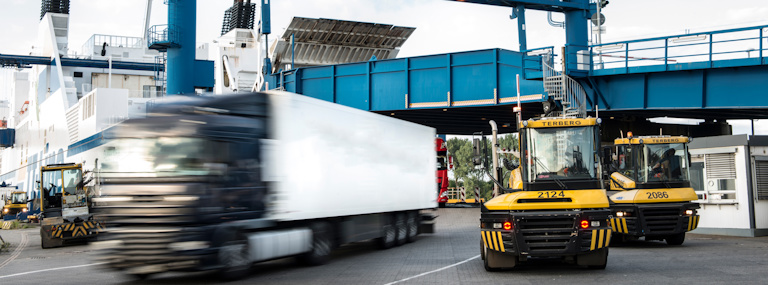
Operations
Here you will find important information about shipping your accompanied and unaccompanied units with TT-Line.
The Operational Guideline provides you with an explanation of the check-in procedure for accompanied units and the delivery and collection of unaccompanied units. An explanation of the procedures for other processes, such as the shipment of dangerous goods, container delivery in the port of Rostock and the stacking service in Trelleborg can also be found here.
-
Check-In processes per harbour
Please find here an explanation of the Check-In procedures in the several ports.
-
Shipping Dangerous Goods with TT-Line
We can accept a variety of dangerous goods types. Here you can find more information about our handling of dangerous goods.
Read more
-
Heavy transportation within Port Rostock
Heavy transportation within Port Rostock
Here you will find information on the delivery and collection of heavy loads in the port of Rostock.
Heavy transportation within Port Rostock Read more
-
Container Delivery/ Pick-up in Rostock
Here you will find more information about the delivery and collection of containers at the Rostock overseas port by truck via road.
Read more
-
Stacking Service Trelleborg
Please find an explanation of the Container and Trailer Stacking service in the port of Trelleborg here.
Read more
-
Transhipments between Germany and Lithuania
In addition to the connection from Sweden to Klaipeda in Lithuania, TT-Line also offers connections from Travemünde and Rostock in Germany. Here you can find more information about these connections, which include a transhipment in Trelleborg.
Read more
-
Customs clearance, exemption
- TT-Line is not authorized or obliged to declare any goods to the customs authorities (see Art. 139 et seq UCC). The presentation obligation is the sole responsibility of the shipper, who has to take care of it.
- TT-Line cannot be charged with opening / terminating customs transit procedures.
- The shipper exempts TT-Line internally from any claims of third parties (in particular the customs and tax authorities) in
connection with customs clearance.
-
Lashing-Points
Loading units must have a sufficient number of lashing eyes suitable for carriage by sea!
It is basically ordered by the maritime authority that the captain can decide not to transport loading units without lashing points.
TT-Line only ships units with lashing points.This also applies to the vehicles without dangerous goods. It is thus possible to secure the cargo units even in severe weather conditions and to optimize the safety on board.
Securing points on road vehicles
Securing points on road vehicles should be designed for securing the road vehicles to the ship and should have an aperture capable of accepting only one lashing. The securing point and aperture should permit varying directions of the lashing to the ship's deck.
The same number of not less than two or more than six securing points should be provided on each side of the road vehicle.
Subject to the provisions of the previous points, the minimum number and thickness of securing points should be as shown in the following table:
Grass vehicle mass (GVM) tonnes Minimum number of securing points on each side of the road vehicle Minimum strength without permanent deformation of each securing point as fitted
(kN)3.5 t ≤ GVM ≤ 20 t
20 t < GVM ≤ 30 t
30 t < GVM ≤ 40 t2
3
4GVM X 10 X 1.2
n*If you have any further questions, please contact our booking department for further information.